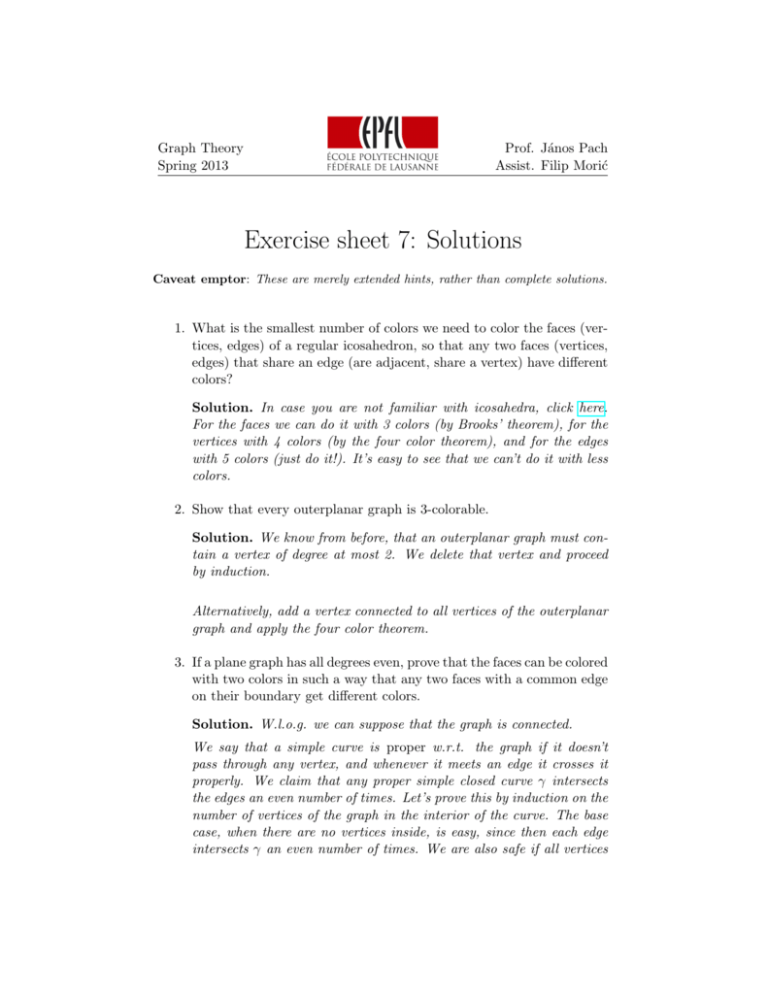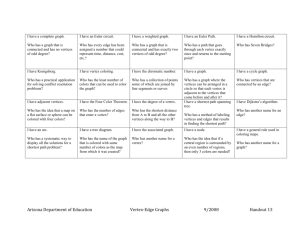Solutions 7
advertisement

Graph Theory Spring 2013 Prof. János Pach Assist. Filip Morić Exercise sheet 7: Solutions Caveat emptor: These are merely extended hints, rather than complete solutions. 1. What is the smallest number of colors we need to color the faces (vertices, edges) of a regular icosahedron, so that any two faces (vertices, edges) that share an edge (are adjacent, share a vertex) have different colors? Solution. In case you are not familiar with icosahedra, click here. For the faces we can do it with 3 colors (by Brooks’ theorem), for the vertices with 4 colors (by the four color theorem), and for the edges with 5 colors (just do it!). It’s easy to see that we can’t do it with less colors. 2. Show that every outerplanar graph is 3-colorable. Solution. We know from before, that an outerplanar graph must contain a vertex of degree at most 2. We delete that vertex and proceed by induction. Alternatively, add a vertex connected to all vertices of the outerplanar graph and apply the four color theorem. 3. If a plane graph has all degrees even, prove that the faces can be colored with two colors in such a way that any two faces with a common edge on their boundary get different colors. Solution. W.l.o.g. we can suppose that the graph is connected. We say that a simple curve is proper w.r.t. the graph if it doesn’t pass through any vertex, and whenever it meets an edge it crosses it properly. We claim that any proper simple closed curve γ intersects the edges an even number of times. Let’s prove this by induction on the number of vertices of the graph in the interior of the curve. The base case, when there are no vertices inside, is easy, since then each edge intersects γ an even number of times. We are also safe if all vertices Graph Theory Spring 2013 Prof. János Pach Assist. Filip Morić are outside. If there are some vertices inside and some vertices outside, then there is an edge uv such u is inside and v is outside. Let x be the first intersection of the edge uv with the curve γ when going from u to v. We can transform the curve γ locally as in the picture, pushing the vertex u outside. The parity of the number of intersection between γ and the edges didn’t change, and the number of internal vertices is one less, so we are done by induction. This implies that the dual graph contains no odd cycles, so it’s 2colorable. γ v x u For an alternative solution, just note that since the graph is Eulerian, the problem is equivalent to Bonus Problem 1 from Sheet 6. 4. Prove that you can color the integer lattice Z2 with four colors, such that any two points that can see each other have distinct colors. (Two points u, v ∈ Z2 can see each other if the interior of the segment uv does not contain a point from Z2 .) Solution. Set the color of (x, y) to be (x mod 2, y mod 2). Then if two points u, v have the same color, the midpoint of the segment uv is a lattice point. 5. Given a set of lines in the plane with no three meeting at a point, form a graph G whose vertices are the intersections of the lines, with two vertices adjacent if they appear consecutively on one of the lines. Prove that χ(G) ≤ 3. Solution. Color the points in the lexicographic order (w.r.t. their coordinates), one by one. Each subsequent point has at most two neighbors that are already colored. Graph Theory Spring 2013 Prof. János Pach Assist. Filip Morić 6. There are 1900 one-Swiss-franc coins lying on an enormous table. Some of them might touch each other, but they don’t overlap. Show that you can always choose 475 of them such that no two chosen coins touch each other. Can you always choose 601 such coins? Solution. Proof that we can always choose 475 non-touching circles: It suffices to show that the corresponding graph is 4-colorable. We can invoke the four-color theorem, but that’d be overkill, as we can prove it easily directly, by induction on the number of circles. Consider the leftmost circles (there might be more than one of them) and among them choose the topmost one. The chosen circle touches at most 3 other circles. All the circles except for the chosen one can be properly colored by 4 colors 1,2,3,4 by induction. Then we can safely color the chosen circle by one of the colors that is free. Proof that sometimes we cannot choose more than 600 nontouching circles: Just consider the situation when we have 100 copies of the configuration from the picture. From each copy we can choose no more than 6 independent vertices. If you spot any mistakes on this sheet, please drop an email to filip.moric@epfl.ch.








